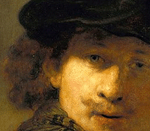
"Denial of St. Peter. (La Negazione di Pietro)"
According to the account in the Gospels (Matthew 26:69–75; Mark 14:66–72; Luke 22:55–62; John 18:17–18, 25–27), when Christ was arrested Peter followed him into the courtyard "to Annas, who was the father-in-law of Caiaphas, the high priest that year" (following John 18:13). There he was accused at three separate confrontations of being a disciple of Jesus. Peter denied each and thus fulfilled Christ's prophecy that before the cock crowed he would deny him thrice.
Caravaggio's paintings have been characterized by art critics as combining a realistic observation of the human state, both physical and emotional, with a dramatic use of lighting, which had a formative influence on Baroque painting.
Caravaggio employed close physical observation with a dramatic use of chiaroscuro that came to be known as tenebrism. He made the technique a dominant stylistic element, transfixing subjects in bright shafts of light and darkening shadows. Caravaggio vividly expressed crucial moments and scenes, often featuring violent struggles, torture, and death.
In October 1609, Caravaggio was attacked by assailants at a tavern in Naples. It seems he never fully recovered from the attack and this is evidenced by broad brushwork and an unfocused quality to the work. Caravaggio crops the figures closely and smothers large areas in shadow in order to avoid any awkward depictions of human physicality. His paintings also represented a psychological intensity which was common in his later work